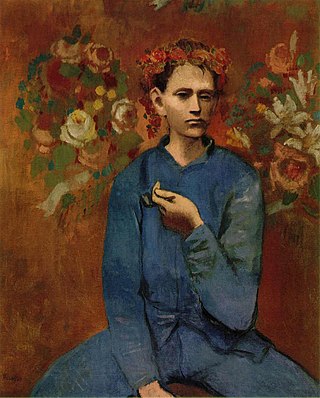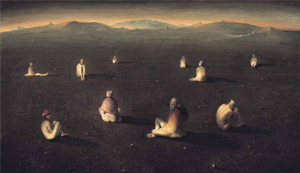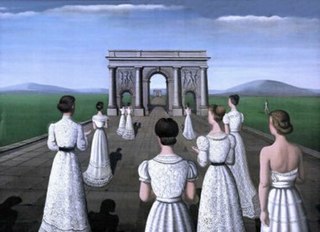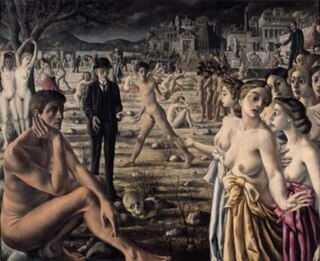
Sir Lawrence Alma-Tadema was a Dutch painter who later settled in the United Kingdom, becoming the last officially recognised denizen in 1873. Born in Dronryp, the Netherlands, and trained at the Royal Academy of Antwerp, Belgium, he settled in London, England in 1870 and spent the rest of his life there.

Barnett Newman was an American painter. He has been critically regarded as one of the major figures of abstract expressionism, and one of the foremost color field painters. His paintings explore the sense of place that viewers experience with art and incorporate the simplest forms to emphasize this feeling.

Garçon à la Pipe is an oil on canvas painting by Pablo Picasso. It was painted in 1905 when Picasso was 24 years old, during his Rose Period, soon after he settled in the Montmartre area of Paris. The painting depicts a Parisian adolescent boy who holds a pipe in his left hand and wears a garland of flowers on his head, surrounded by two floral decorations. The subject was a local boy named "P’tit Louis" who died at a young age. The painting is listed as one of the most expensive paintings, after being sold at Sotheby's auction for $104 million on 5 May 2004. It is currently the fifth highest selling painting by Picasso.

Paul Delvaux was a Belgian painter noted for his dream-like scenes of women, classical architecture, trains and train stations, and skeletons, often in combination. He is often considered a surrealist, although he only briefly identified with the Surrealist movement. He was influenced by the works of Giorgio de Chirico and René Magritte, but developed his own fantastical subjects and hyper-realistic styling, combining the detailed classical beauty of academic painting with the bizarre juxtapositions of surrealism.
Jennifer Anne Saville is a contemporary British painter and an original member of the Young British Artists.

Edwin Parker "Cy" Twombly Jr. was an American painter, sculptor and photographer.

Pan Yuliang, born as Chen Xiuqing, also known as Zhang Yuliang (張玉良), is remembered as the first woman in China to paint in the Western style. She studied in Shanghai and Paris, and taught at the École des Beaux Arts. In 1985, much of her work was transported to China, and collected by the National Art Museum in Beijing and the Anhui Museum in Hefei. Despite being remembered for introducing Western paintings to China, she also provided a new lens to how women were seen through her paintings, not just as objects but as subjects. She won several awards for her work and exhibited internationally in Europe, the United States, and Japan. Significant paintings, sculptures, and prints by her are still conserved in France in the collection of the Cernuschi museum. Her life as an artist has been portrayed in novels, films, and operas in China and the United States. Her art evolved within the flux of conflicting dichotomies of East and West, tradition and modernity, male chauvinism and emerging feminism. Pan is also remembered as an artist who engaged with labels, such as "contemporary/modern," "Chinese," and "woman" artist, while also questioning them.

Hendrick van Cleve or Hendrik van Cleve III was a Flemish painter, draughtsman and designer of prints. He is known for topographical views, including views of Rome and the Vatican, as well as imaginary landscapes. Traditionally, a large number of depictions of the construction of the Tower of Babel have been attributed to him but most of these are now attributed to anonymous Flemish painters, who are referred to as 'The Hendrik van Cleve III Group'.

Paul Emil Jacobs was a German painter, noted for Orientalist themes, portraits and nudes.

Night Train is a 1947 painting by Belgian artist Paul Delvaux, famous for his paintings of female nudes. The painting is 153 x 210 centimetres and is now in the Museum of Modern Art, in Toyama, in Japan.

The Rape of Ganymede is a painting by the Flemish Baroque painter Peter Paul Rubens produced between 1636 and 1638 painting for the Spanish king Philip IV of Spain's hunting lodge. The painting is based on a story recounted in classical poet Ovid's Metamorphoses. It depicts the moment when the Roman supreme god Jupiter disguised as an eagle catches the young shepherd Ganymede and lifts him into the air. It is in the collection of the Museo del Prado in Madrid. The dramatic scene gave Rubens ample opportunity to show his skill in depicting a lively scene and the nude.

Lunatics is a 2002 oil on canvas painting by the Norwegian painter Odd Nerdrum. It depicts a barren landscape with a number of nude or semi-nude people wearing headgears such as crowns and helmets. In their 2014 catalogue note, Sotheby's described the painting as "a quintessential example of Nerdrum's large-scale allegories, presenting a sense of the apocalyptic".

The Great Sirens is a large 1947 painting by the Belgian painter Paul Delvaux in the collection of the Metropolitan Museum of Art, in New York.

Blonde Bather is the name of two very similar paintings by French painter Pierre-Auguste Renoir, created in 1881 and 1882. The model was Aline Charigot, later to become Renoir's wife. Influenced by Renaissance painting that Renoir saw in Italy in 1881, both paintings show a marked change of style from Renoir's previous work. Some commentators consider these are works of great beauty while others find them vulgar. There has been criticism of the conservation work performed on the 1881 painting.

Le Repos is an oil-on-canvas painting created by Pablo Picasso in 1932. It depicts a portrait of Marie-Thérèse Walter, the artist's lover and muse, in a sleeping pose. The painting was produced in the midst of their relationship and is a demonstration of Picasso's love for his mistress. Le Repos was one of a series of sleeping portraits of Walter that Picasso created in 1932. On 14 May 2018, the painting achieved a value of $36.9 million when it was sold at Sotheby's auction.

The Temple is a painting made in 1949 by the Belgian artist Paul Delvaux. It depicts a classical temple building in moonlight, with the head of a statue and several modern objects in the foreground. The painting was made in Choisel outside Paris where Delvaux lived temporarily with his lover and future wife Anne-Marie "Tam" de Maertelaere. It is an oil painting with the dimensions 113.7 cm × 146 cm.

Procession in Lace is a painting executed by the Belgian artist Paul Delvaux in 1936. It shows a group of women walking toward a Roman triumphal arch. It was one of the first paintings in which Delvaux drew inspiration from Giorgio de Chirico and painted women reminiscent of mannequins, something he would continue to do throughout his career. Art historians have highlighted the painting's theatricality and described it as one of Delvaux's first major works.

Sleeping Venus is a 1944 painting by the Belgian artist Paul Delvaux. It depicts a reclining Venus surrounded by anguished people at a town square with classical buildings. It was painted in Brussels while the city was bombed during World War II and Delvaux wanted to contrast the psychological drama of the moment with the calm Venus. The painting has been in the collection of Tate in London since 1957.

The Anxious City is a painting made by Paul Delvaux in 1940–1941. It depicts a large number of upset people, most of whom are nude or partially nude, in front of a lake and classical structures. Among the characters who stand out are a naked self-portrait of Delvaux, a man in a bowler hat and a group of bare-breasted women. The man with the bowler hat made his debut in The Anxious City and would appear in several other Delvaux paintings.


















